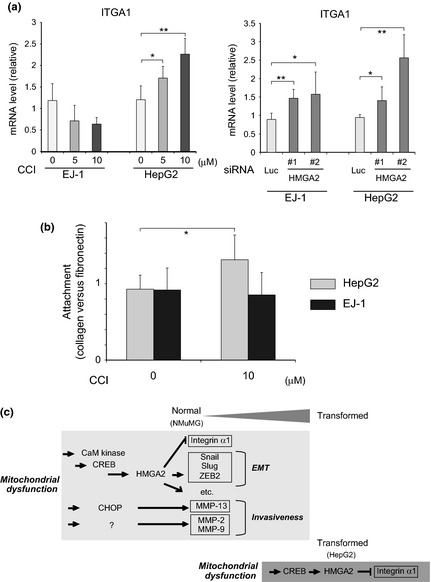Figure 6.

The cAMP‐responsive element‐binding protein (CREB)/high mobility group AT‐hook 2 (HMGA2) pathway decreases ITGA1 expression in HepG2 cells. (a) HepG2 and EJ‐1 cells were treated with CCI at the indicated doses for 20 h or with siRNA for HMGA2 (50 nM for 48 h) and examined by real‐time RT‐PCR to determine ITGA1 expression. The knockdown effects of the HMGA2 siRNA are shown in Figure S1c. A ratio relative to the control is shown. *P < 0.05, **P < 0.005. (b) Cells pretreated with CCI for 48 h were dissociated, plated onto collagen‐coated and fibronectin‐coated wells, and processed for the attachment assay, as described in the Materials and Methods section. A ratio of the cell number in the collagen‐coated wells to that in fibronectin‐coated wells is shown. *P < 0.05. (c) Contribution of mitochondrial dysfunction to malignant transformation of epithelial cells. Mitochondrial dysfunction propagated stress signaling by activating CREB‐mediated and C/EBP homologous protein‐10 (CHOP)‐mediated transcriptional networks. HMGA2 played an intermediary role in the CREB pathway and regulated a variety of transcriptional activities downstream. In non‐transformed NMuMG mouse mammary epithelial cells, the epithelial–mesenchymal transition (EMT) regulators and ITGA1 were regulated downstream of HMGA2. Together with previous findings.12 the cascades and their targets that potentially contribute to neoplastic transformation are shown. In the HepG2‐transformed cancer cell line, the CREB/HMGA2 axis is suggested to be active in regulating the expression of ITGA1, but not the EMT (see text). **P < 0.005, ***P < 0.00005.
